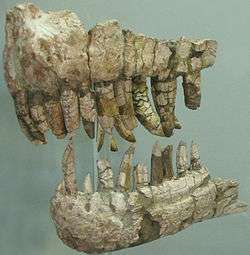Cerro Barcino Formation
| Cerro Barcino Formation Stratigraphic range: Hauterivian-Albian ~130–100 Ma | |
|---|---|
| Type | Geological formation |
| Unit of | Chubut Group |
| Sub-units |
Puesto Manuel Arce Bayo Overo Las Plumas Cerro Castaño La Paloma |
| Underlies | La Colonia, Paso del Sapo & Lefipán Formations |
| Overlies | Los Adobes Formation |
| Lithology | |
| Primary | Mudstone, sandstone |
| Other | Conglomerate, tuff |
| Location | |
| Coordinates | 43°48′S 68°36′W / 43.8°S 68.6°WCoordinates: 43°48′S 68°36′W / 43.8°S 68.6°W |
| Approximate paleocoordinates | 44°42′S 35°06′W / 44.7°S 35.1°W |
| Region | Chubut Province |
| Country |
|
| Extent | Cañadón Asfalto Basin |
| Type section | |
| Named for | Cerro Barcino |
The Cerro Barcino Formation (also known as the Gorro Frigio Formation) is a geological formation in South America whose strata span the Early Cretaceous. The top age for the formation has been estimated to be Albian.[1] Earlier estimates placed the formation until the Campanian.[2]
The formation was deposited in the Cañadón Asfalto Basin, a rift basin that started forming in the earliest Jurassic.[3] Dinosaur remains are among the fossils that have been recovered from the formation.[4]
The Cerro Barcino Formation is the second-youngest unit of the Chubut Group, which also includes the older Los Adobes Formation. Both formations cover a vast area in Chubut Province, Argentina. The two formations are distinguished by geological features suggesting a distinct change in climate, from a wetter, flood plain environment in the Los Adobes to a much more arid, desert-like environment in the Cerro Barcino.[2]
The Cerro Barcino Formation is subdivided into several subunits ("members").[2] From oldest to youngest:
- La Paloma
- Characterized by arid plains interspersed with sand dunes
- Cerro Castaño
- A return to more humid, flood-plain conditions
- Las Plumas
- Bayo Overo
- Puesto Manuel Arce
The final three members were estimated to range from Albian to Campanian age (112 to 83 million years ago), while the La Paloma dates to the latest Hauterivian (130 Ma).[2]
Fauna
Indeterminate abelisaurid remains.[4] Possible indeterminate carcharodontosaurid remains.[4] Indeterminate Titanosauria remains.[4] Also, an unnamed titanosauriform.[4]
Crurotarsans
Color key
|
Notes Uncertain or tentative taxa are in small text; |
| Crocodylomorphs of the Adamantina Formation | ||||||
|---|---|---|---|---|---|---|
| Genus | Species | Location | Stratigraphic position | Material | Notes | Images |
|
B. gradilis |
Near El Escorial village, Chubut Province. |
Cerro Castaño Member. |
"Skull, mandible, and postcranial remains." |
A peirosaurid. The first crocodyliform from the Chubut Group. |
||
Dinosaurs
| Dinosaurs of the Cerro Barcino Formation | |||||
|---|---|---|---|---|---|
| Genus | Species | Presence | Material | Notes | Images |
|
Chubutisaurus insignis |
Present in the Bayo Overo Member. |
"[Two] partial skeletons including most limb elements and caudal vertebrae."[6] |
| ||
|
Genyodectes serus |
Present in the Cerro Castaño Member.[7] |
"Premaxillae, partial dentaries."[8] |
A possible ceratosaurid. | ||
|
"Megalosaurus" |
"Megalosaurus" inexpectatus |
Indeterminate remains originally described as a species of Megalosaurus.[4] | |||
|
Patagotitan mayorum |
|||||
|
Tyrannotitan chubutensis |
Present in the Cerro Castaño Member. |
||||
See also
References
- ↑ Figari et al., 2015, p.153
- 1 2 3 4 Rauhut, O.W.M., Cladera, G., Vickers-Rich, P. and Rich, T.H. (2003). "Dinosaur remains from the Lower Cretaceous of the Chubut Group, Argentina." Cretaceous Research, 24(5): 487-497. doi:10.1016/S0195-6671(03)00067-3
- ↑ Figari et al., 2015, p.142
- 1 2 3 4 5 6 7 Weishampel, David B; et al. (2004). "Dinosaur distribution (Early Cretaceous, South America)." In: Weishampel, David B.; Dodson, Peter; and Osmólska, Halszka (eds.): The Dinosauria, 2nd, Berkeley: University of California Press. Pp. 563-570. ISBN 0-520-24209-2.
- ↑ Juan Martín Leardi and Diego Pol (2009). "The first crocodyliform from the Chubut Group (Chubut Province, Argentina) and its phylogenetic position within basal Mesoeucrocodylia". Cretaceous Research. 30 (6): 1376–1386. doi:10.1016/j.cretres.2009.08.002.
- ↑ "Table 13.1," in Weishampel, et al. (2004). Page 268.
- ↑ Rauhut, O.W.M. (2004). Provenance and anatomy of Genyodectes serus, a large-toothed ceratosaur (Dinosauria: Theropoda) from Patagonia. Journal of Vertebrate Paleontology 24(4):894-902.
- ↑ "Table 3.1," in Weishampel, et al. (2004). Page 50.
- ↑ Novas, F. E.; S. de Valais; P. Vickers-Rich; T. Rich (2005). "A large Cretaceous theropod from Patagonia, Argentina, and the evolution of carcharodontosaurids". Naturwissenschaften. 92 (5): 226–230. Bibcode:2005NW.....92..226N. doi:10.1007/s00114-005-0623-3. PMID 15834691.
Bibliography
- Figari, Eduardo G.; Roberto A. Scasso; Rubén N. Cúneo, and Ignacio Escapa. 2015. Estratigrafía y evolución geológica de la Cuenca de Cañadón Asfalto, Provincia del Chubut, Argentina. Latin American Journal of Sedimentology and Basin Analysis 22. 135–169. Accessed 2018-09-10.
